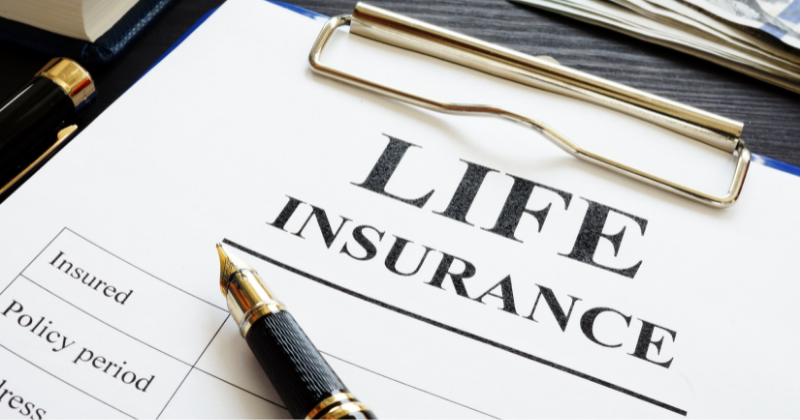In Australia, you have many options for life insurance policies. However, with so many options available to you, what types of life insurance policies matter most to you, and how should you choose what is suitable for you and your family?

In this article, we explore how different types of life insurance in Australia work and equip you with the details you need to help determine what is best for your situation and needs.
No matter what types of life insurance you decide to secure, it’s important to consider:
- How much life insurance you need/your family needs
- What the cost of your life insurance premiums will be
- Different quotes and costs from an insurance company/insurance companies
- Whether your life insurance policy guarantees your financial security for the future
What Is Life Insurance?
In Australia, life insurance is designed to protect you and your family financially if something unexpected happens.
There are 4 main types of life insurance designed to financially protect you and your family from different scenarios such as:
- death
- terminal illness
- a severe injury or illness that prevents you from working
- permanent disability
The four types of life insurance work in different ways but ultimately, if you need to make a claim on your policy, the life insurer pays you money (a one-off lump sum or ongoing repayments depending on your policy).
Life insurance types are often called “products” or “financial products” which just refers to your policy.
What Types of Life Insurance Are There in Australia?
There are four main life insurance policy types in Australia. Although there are other types of insurance covers, these four policy types are considered the main ‘life insurance types’:
- Life Cover (also known as Death Cover)
- Income Protection Insurance
- Total and Permanent Disability
- Trauma Insurance
It’s important to select the right types of life insurance that are relevant to your situation so you can have peace of mind that you and your family will be protected no matter what life throws your way.
- Life Cover (Also Known As Death Cover or Term Life Insurance)
Life cover insurance is paid out in a lump sum to your family and loved ones in the instance of your death.
It is usually available for those between the ages of 18 and 79.
Part of enrolling in life cover insurance is selecting your beneficiaries in the event of your death. For most, these are direct family members. However, everyone’s situation is different.
Then, your life cover pays a specific amount, also called a death benefit, to your beneficiary after you pass away.
It is essential to choose who your beneficiaries will be and to discuss the nature of their financial situation and needs if you were to pass away.
the primary purpose of life insurance is to provide a financial cushion to preserve your way of life and that of your family should you suffer a terminal illness or death.
It is designed to provide peace of mind as you’re assured coverage for your family’s quality of life and the financial security of the future of your beneficiaries.
Term life insurance is the most common and most frequently utilised life insurance in Australia.
Everyone’s financial and lifestyle situation is different. However, when one is considering term life insurance options, they should plan for enough of a benefit to cover:
- Any and all existing debts (including a mortgage)
- The income they would have generated before retirement age or after retirement age that their family relies on
- Any costs involved in their children’s schooling for the future
- Any funeral costs that your family may need to provide for
- Any additional money or inheritances they wish to leave for their family
- Income Protection Insurance
Income Protection (IP) insurance covers help Australians protect their greatest asset: their ability to earn income.
IP cover provides financial assistance in the event that you are unable to make money and earn an income due to disability caused by injury or illness.
Income protection insurance offers an ongoing income stream of up to 70% of your regular monthly salary. These particular insurance benefits are generally paid monthly. IP is usually available to those ages 18 to 64.
Payouts for income protection are generally assessed based on pre-tax income for those who earn salaries. In contrast, benefits for self-employed individuals are usually evaluated according to net income after deducting the expenses.
This protection is not only where you can’t work for long periods of time – IP insurance can assist where you’re unable to work for a small amount of time due to a temporary illness or injury. This money can be used to cover living expenses such as mortgage and loan payments, health issues, rent etc.
Additionally, your IP life insurance premiums are usually tax deductible.
- Total and Permanent Disability (TPD) Insurance
TPD Insurance can help support you and your family (including dependents) financially in the event that you suffer a permanent illness or injury resulting in you never being able to return to work again.
Total and Permanent Disability Insurance (TPD insurance) pays a lump sum to help you cover the costs of your illness/injury. It can be used to supplement your lost income. It can cover day-to-day living expenses as well as medical and rehabilitation expenses.
This type of insurance is usually available to those aged between 18 and 64. TPD insurance can help pay any debts and cover pertinent medical costs if you become permanently unable to work.
It is important to note that there are generally two accepted definitions of TPD. Some providers may allow you to determine which of these two you would prefer to use when enrolling.
- Any occupation: in this definition, an insured person cannot perform any paid work now or for the rest of their life; specifically, work for which they are acceptably and demonstrably qualified, even if they have not worked in that capacity prior.
- Own occupation: in this definition, an insured person cannot work again in their typical profession.
You can apply for TPD cover individually or add this insurance to an existing life insurance policy. Additionally, you can bundle it together with some of the other types of life insurance.
A TPD insurance claim benefit may help offset lost wages, eliminate debts and help with any updates to your dwelling that are required due to your particular physical needs (such as wheelchair ramps, and the like).
- Trauma Insurance
Trauma insurance cover, sometimes called recovery insurance or critical illness cover, pays a lump-sum benefit to cover recovery time if you are diagnosed with an acute, particular disease or serious illness.
Critical illness and injury conditions that are often covered under trauma insurance policies include:
- Major head injuries
- Coronary heart diseases
- Stroke
- Cancer
- Terminal illnesses
Trauma insurance is generally available to those between the ages of 18 and 64.
It may cover, in certain situations, any medical treatment expenses that are not covered by Medicare/private health insurance, if you were to endure a serious medical condition such as heart attack, stroke, cancer and coronary artery bypass surgery. These items account for more than 90% of all trauma insurance cover claims.

I want to see all my options with the help of a Finance Expert
Call Our Team TodayHow Does Life Insurance Work?
Depending on your policy type, life insurance works by providing you with a financial payment in the event you pass away, suffer a severe illness or injury or are unable to work.
This process is initiated by receiving approval from a life insurance provider and then determining your benefit amount (in other words, how much money or financial support are you (or your family) entitled to.
This amount, and the details of how it is facilitated, will vary according to the particular life insurance company you choose to go with.
In some cases, you may be asked to have a medical exam before being eligible to take out a policy. Your insurance benefit number may also be limited contingent upon your particular age bracket.
Most life insurance products have a minimum period after policy enrollment before a person can receive any benefits.
Life insurance in Australia can likewise cover you for situations of terminal illnesses, meaning you can utilise your life insurance payment if a medical professional draws a reasonably concrete conclusion that you will die soon. Each healthcare provider will utilise their specific standards for considering a terminal illness. However, a terminal illness diagnosis from a medical professional usually means that a person has one year or less of life.
Just as there are subjective measures like this in the medical world, keep in mind that each individual life insurance policy operates according to different exclusions, stipulations, and caps.
Other Different Types of Insurance and Life Insurance
Funeral Insurance
Funeral insurance is generally paid as a lump sum and generally provides up to $15,000 to cover any costs associated with your funeral. This type of insurance is widely available to those between 18 and 79 years old.
Accidental Death Insurance
Accidental death insurance pays a lump sum benefit to your nominated beneficiary or estate if you were to pass away due to an accident.
This particular type of insurance is normally paid as a lump sum. It provides cover for accidental injury or death and is available for those aged between 18 and 64.
This type of insurance is similar to life cover insurance. However, no payments are made for death caused by an illness – only injury.
For accidental injury or death insurance, the injury or death cannot be caused by or related to pre-existing health conditions or issues.
However, each provider may offer slightly different stipulations on what constitutes accidental injury or death.
Whole Life Insurance
Unlike term life insurance, which is very common in Australia, whole life insurance is not available in Australia anymore. However, those with an existing whole life policy may still be able to keep this policy.
Whole life insurance policies are considered permanent life insurance policies and mean the insured is covered for their entire life rather than a specific amount of time (like term life cover).
While term life insurance only pays benefits based on premiums to a beneficiary for a certain term of their life, for example, up to age 80, whole life insurance does not have term restrictions like these and pays a beneficiary’s family regardless of when the beneficiary passes away.
In addition, whole life insurance also differed from term life insurance in that it included an investment component. A portion of each premium paid would be set aside in a savings account and invested by the policy grantor for the purpose of earning interest for the policyholder. These earnings, which can not be lost, were defined as the cash value or surrender value of the policy.
Whole life insurance is now no longer an option for citizens in Australia, although it is sometimes used by those who enrolled in whole life insurance policies before 1992.
Universal Life Insurance
Universal life insurance, also called “variable universal life insurance,” is a kind of permanent life insurance with variable (hence the name) terms and investment options. While it is popular in other countries, like the United States, it is not available in Australia.
The main distinction between universal life insurance and other forms of permanent life insurance (like term or group life insurance) is the ability to have flexible premiums and to flexibly adjust terms such as lowering or increasing your death benefit for your loved ones, within certain restrictions.
With universal life insurance, you are also able to make changes to items like the schedule and amount that you pay premiums, such as changing from monthly to yearly or vice versa, decreasing premium payments for a certain period of time, and so on. This is a kind of investment insurance policy, and part of its benefit is that one can alter how one’s policy’s value is invested among several different investment options.
Survivorship Life Insurance
Survivorship life insurance, also called “joint life insurance,” is a type of life insurance structure designed for couples that only pays benefits after both members of the couple die.
There are two types of joint life insurance policies. For a “first-to-die” policy, the insurance provider pays a benefit after the first insured person dies. “Second-to-die” policies are policies that are more typically called “survivorship policies,” in which case the benefit is only given after the surviving person also passes away. The benefit payout goes to the couple’s beneficiaries.
These beneficiaries do not have to be children of the couple; this policy type can simply be used to streamline the transfer of assets to a friend or business partner, for example.
Survivorship life insurance is often a tool utilised by wealthier couples who want to ease their tax obligations for their children upon their death. A surviving spouse does not have a tax obligation with a survivorship life insurance structure after the first spouse passes away.
Credit Insurance
Not unlike mortgage life insurance, credit life insurance is a kind of term life insurance that pays a person’s debts and financial obligations in the event of their death.
The term of this type of insurance corresponds to the term of the loan whose payments the policy is clearing, and as payments are diminished over time as the loan decreases, the benefits paid by the insurance policy also decrease.
Credit life insurance policies tend to have less stringent underwriting requirements than other policies. In some situations, these policies are a requirement for taking out a type of loan.
One of the most practical reasons for these policies is to protect family members of a policyholder so that they do not inherit a large debt upon the policy holder’s death which they may be unable to pay.
Supplemental Life Insurance
Supplemental life insurance is designed to do what its name implies: supplement or fill in any gaps in a current life insurance policy.
For a couple living in a lower income area with minimal expenses, a standard term life insurance policy might be enough to support the non-working partner in the case that the working partner dies.
However, for a family of seven with a working husband, a stay-at-home mom, and five children, the odds that a typical term life insurance policy will be enough to support the remaining family members in the event of the husband’s death are very low.
Supplemental life insurance is an additional policy that can supplement a potential lack of income in the event of the policy holder’s death.
In many cases, a person can obtain supplemental life insurance through their work. However, it can also be obtained privately as well.
Which Type of Life Insurance Policy Combines Insurance and Investing?
For some people, life insurance offers a vehicle for investing as well. For those in Australia who have whole life insurance policies that started before 1992, they are able to utilise their insurance policy as an investment vehicle.
Whole life insurance policies are a type of permanent life insurance that typically have an investment component as part of their structure. The policy pays a single, predetermined premium benefit upon your death, and in return for being a long term, fixed policy, invests part of your premium toward building cash value from investments the insurance company executes over time.
One advantage of whole life policies is that this cash value builds in a tax-deferred environment over time as long as you maintain the policy, and you are able to borrow from this amount as well.
However, whole life policies are unable to be purchased in Australia any more so this will only be an option for those with existing policies in place.
Other life insurance policies with an investment component are universal and variable universal life insurance policies, which are similar to whole life insurance policies but have more flexibility in terms of the term and amount of the policy.
Additionally, the investment component for these kinds of policies is geared toward money market investing and stock investing, meaning that the returns on these investments can tend to be higher, although there is more volatility than with the investment vehicles used in traditional whole life insurance policies. Because there is more volatility, the rate of return on these investments is not guaranteed.

What Type of Life Insurance Should You Get?
Determining what type of life insurance you should get requires several key considerations – especially to consider if you need more than one type of insurance policy for maximum protection.
Life Cover might be for you if:
- Your spouse or dependents rely on your income
- You have debts and mortgage repayments that will be left with your family if you were to pass away
- You want to provide for your family when you are no longer around
- You want to leave an inheritance for your children / grandchildren
- You want to pay for funeral costs so your family won’t be financially challenged
TPD Insurance might be for you if:
- You want financial protection in the event you become unable to work again
- Your spouse or dependents rely on your income
- You have debts and mortgage repayments that you still need to pay even if you don’t have an income
- You don’t have access to savings or income that sustain you for the rest of your life
Trauma Insurance might be for you if:
- You want financial support in the event you suffer a severe illness/injury
- You have existing health conditions or a history of medical conditions in the family that put you at a high probability of being diagnosed with a severe illness
- You don’t have other existing insurance policies (such as health insurance, TPD or income protection) that may help cover your medical/living expenses
- You don’t have access to savings, emergency funds or income that could help provide for you if you suffer a medical condition or illness
- Your spouse of family rely on your income and would be at financial risk if you couldn’t work for a significant period of time
- You don’t have access to a significant amount of leave at work (sick leave or annual leave) – especially if you are self-employed
Income Protection Insurance might be for you if:
- Your spouse or dependents rely on your income
- You have debts and mortgage repayments that you still need to pay even if you don’t have an income
- You don’t have access to a significant amount of leave at work (sick leave or annual leave) – especially if you are self-employed
- You don’t have access to savings, emergency funds or income that could help provide for you if you can’t work for a period of time
- You don’t have other existing insurance policies (such as health insurance, TPD or trauma cover) that may help cover your living expenses
- You participate in dangerous hobbies or activeities and are at more risk of suffering an injury or illness
What to Check Before You Buy Life Insurance
There are a few things you want to consider when evaluating what life insurance you might want to get.
- Have a clear picture of your financial situation
For some, this may be as simple as checking their savings account. For others with a more complicated financial situation with various moving parts, they will want to have a clear picture of their assets, liabilities, debts, investment portfolio, estate taxes and so on before committing to regular life insurance premium payments. - Determine how much cover you need
There are so many life insurance options out there that it’s important to determine how much cover you need to secure your future and that of your family.
So many Australians are underinsured so it’s vital to ensure that despite the potential higher cost, the death benefit or cash value of the benefit is enough to sustain your lifestyle. - Decide which life insurance company or provider you want
With so many insurance companies to choose from, it’s important you do your research around quality, price and customer service.
Take a look at the claims history of the insurance provider. These records are generally available online for public viewing. Review the insurance carrier’s waiting periods or how it has accepted or rejected claims that might be similar to yours, and read the reviews people have to offer.
Importantly, determine if the life insurance company is a legitimate business by checking its Australian business number (ABN) and if the provider has an Australian financial services licence (AFSL). - Read the policy terms and conditions and Product Disclosure Statement (PDS)
Look at the fine print on the policy’s relevant product disclosure statement (PDS). What are the add-ons and exclusions of the policy? What situations will or will not be covered? How do pre-existing conditions and other medical considerations factor into the policy’s terms? It is important to know these things in depth, and how they might apply to your situation. - Calculate the cost of your cover
The cost of your life insurance premiums will likely be a key decider in which policy and provider you choose.
The cost of paying premiums can vary greatly between providers which can have a significant financial effect over long periods. After all, financial protection is the most important thing so it pays to find the best deal.
My Money Sorted works with Australia’s leading and cheapest life insurance providers so that you can get the best deals for you and your family without paying unnecessary costs.
Why Should You Consider Other Types of Insurance if You Already Have Life Insurance?
The big question you should ask instead is, “Do I have peace of mind for every possible area of risk in my life and my family’s life?”
If you already have life insurance in the form of life cover, it may provide enough protection for your family if you were to pass away.
But the 4 types of life insurance can protect you and your family from other scenarios as well. If you were to be out of work for an extended period of time, consider the following:
- Would you have enough savings to afford living expenses
- Do you have outstanding loans such as a mortgage or other debts you would need to keep paying?
- Would you be able to provide for your family until (if ever) you could return to work?
- If you needed to pay additional medical costs, could you afford to do this?
Perhaps you work in an industry that is a bit riskier, and the possibility of getting injured or disabled is higher than you think. Or, perhaps the benefits of your policy simply would not go as far as you think they would go for your family if you were to pass away.
The truth is, accidents and unexpected circumstances happen all the time, and you rarely think that they could ever happen to you. However, they do. Having insurance coverage for the various potential risks in your lifestyle provides peace of mind that you just can’t put a price tag upon.
Can You Combine Life Insurance Cover?
The simple answer here is yes.
The complex answer is not always.
Most insurance companies offer bundle packages that combine several different types of insurance. In many cases, blending different forms of insurance is done with discounts on the premiums in order to make them more affordable and attractive.
You can even combine insurance policies within your super fund. However, keep in mind that super funds do not offer trauma insurance policies.
Generally, you’ll be able to combine a life cover policy with either Trauma cover, a TPD policy or both. The other option that you typically have is to link your trauma insurance and your TPD policy.
Here are some of the likely, common life insurance policy combinations you can select from:
- Life and TPD Cover
- Trauma and Life Cover
- Trauma and TPD Insurance: If you already have a life cover policy, you may decide to keep that as a standalone policy. In that case, you may be able to link a TPD and Trauma insurance policy.
- Life Cover, TPD and Trauma Insurance
Factors Involved in the Life Insurance Quote Process
Life insurers usually fully underwrite each client who applies for any and each of its products.
The underwriting process includes assessing information including:
- age
- medical history
- work
- hobbies
- smoker status
From your details provided, the life insurance provider will assess your risk level and eligibility for the policy.
Where to buy life insurance?
Australians can buy life insurance:
- Directly through the insurer
- Through an insurance broker
- With an adviser
- Through My Money Sorted
My Money Sorted partner with Australia’s leading insurance providers who can help you cut through the confusion and secure the right policy in less time.
Still not sure where to start, or want help securing the right insurance faster?
That’s okay!
Many people may be unaware of this…but just like you, 41% of Aussies intend to get financial advice rather than going it alone, according to an Australian Securities and Investments Commission (ASIC) report.
You can reach out to My Money Sorted to guide you for free before you seek professional advice from an insurance expert!
When you book a call with My Money Sorted, you’ll:
✓ get a better understanding of your money matters
✓ have an idea of your money goals
✓ be matched with the right insurance expert who can help simplify your search for an insurance policy that fits your needs
My Money Sorted is your stress-free pathway to getting ahead with your money. Here’s what your journey will look like:
Step 1: Start off with a quick money matters session with My Money Sorted
Step 2: Get matched with a Insurance Expert that’s right for your money situation
Step 3: Take the first step towards getting the protection you need with a clear and sound roadmap prepared by an Insurance Expert
It’s that easy!










